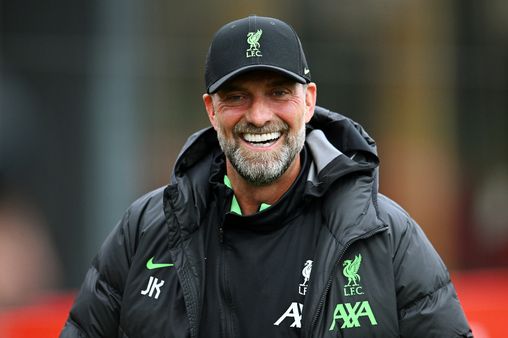Jurgen Klopp has revealed Liverpool’s new ideas that will enhance the club
Jurgen Klopp and Pep Lijnders are quietly developing Liverpool’s game plan with evidence across the club, writes Paul.
Liverpool manager Jurgen Klopp during a training session at the AXA Training Center on October 19, 2023 in Kirkby, England
Jurgen Klopp is training at Liverpool’s AXA Training Center this week
It’s been more than six months since a tactical change significantly increased the demands on Liverpool’s right back.
Without a win in five games, Jurgen Klopp and Pep Lijnders came up with a game plan to add creativity to the team, moving Trent Alexander-Arnold into more central areas, higher up the pitch. Instead of installing the academy graduate in a fixed midfield position, a compromise was reached.
The second half of the 2-2 draw with Arsenal ended with Alexander-Arnold’s newfound freedom to roam. But at the time it seemed much more like a one-off tactic to drag the team back into the match after conceding two goals to the then Premier League leaders. It was a strategy that paid off big as Alexander-Arnold began to cause the Arsenal team all sorts of problems. Mohamed Salah’s penalty was stopped in a 12th defeat in 20 for the Reds under Klopp. The No.66 provided a late assist for Roberto Firmino with a pinpoint cross after beating Oleksandr Zinchenko on Easter Sunday.
While Alexander-Arnold’s adjustment midway through the game was largely Klopp’s roll, the 6-1 thrashing of Leeds later in the game felt far more calculated when England’s run produced assists for Cody Gakpo and Darwin Nunez. Having won just three before the April adjustment, Alexander-Arnold ended a difficult campaign for Liverpool with a total of 10, giving weight to those who supported the move.
Although there are clear areas where the right-back moves slightly away from his defensive position, Liverpool’s plan is designed to dominate the games more, meaning that exploitative moves from opponents are minimal. The full-back becomes a wide three-man formation as the right-back moves higher up the pitch. Basically, it’s about giving Alexander-Arnold the chance to create big scoring chances.
The system did not come without teeth and a lot of work went into making it as smooth as possible, especially during pre-season training. Alexander-Arnold is also understood to have sat down with Klopp and Lijnders earlier this year to analyze clips of their games and work out what was needed.
The visitors made a particular mark at home to Nottingham Forest last season, which left Liverpool internally questioning how to properly adapt, while Bournemouth pressed hard in a 3-1 win at Anfield. In August, Alexander-Arnold finally settled into a more traditional right-back position after missing out on a number of occasions, including the Cherries’ early opener. The defender’s in-game intelligence to simply revert to the traditional right-back eventually led to the equalizer when his cross was finished by Diogo Jota to set up Luis Diaz. These are the tactical nuances Liverpool’s players have to contend with now, and it’s a steep learning curve at the sharp end of the game.
But while the task of dictating play in midfield is relatively new and exciting for a player who has been the creative pinnacle of this Liverpool side for the past five years, it does not come without its own dangers. -moved the 25-year-old Alexander-Arnold, who is now practically being asked to play two positions in the same game. It’s a tactical plan that isn’t just reserved for him either.
“It’s good, something different for me,” says Conor Bradley. “I’m not used to it and I played as a full-back at Bolton – basically as a right-back – but I’m enjoying it. Obviously I’m taking a bit of things from the coaches and from Trent about how to play the game. I played the role and until I was 16 I was a midfielder. I played from 10, so I was in the middle but when I came here to Liverpool I was moved to right back.”
Liverpool’s problem is the unique player they have in Alexander-Arnold. There are few others in the group who can possess such ingenuity. It doesn’t always feel the most free or natural when central defender Joe Gomez, for example, is asked to do something similar. But it is something Liverpool are now looking to implement across all age groups. This can already be seen in the games of the club’s under-18 and under-21 teams this season. It is clear that the decision to bring the defenders to the field was made in the long term.
With Bradley sidelined with a back injury and Calvin Ramsay on loan at Preston North End, the lack of a natural replacement for Alexander-Arnold is obvious, especially since versatile veteran James Milner has left the club. As a result, Klopp also used midfield talents Stefan Bajcetic and Curtis Jones in the Europa League against LASK and the Carabao Cup against Leicester City. Given the demands of it all, it’s not surprising that neither player performed particularly well at full-back.
However, the use of both Bajcetic and Jones there suggests that Liverpool will remain predictable even without Alexander-Arnold. It is also a sign of Klopp that the technical strength of a more traditional midfielder is valued above defensive prowess in the list of skills required to succeed in the role.
Ibrahima Konate has previously spoken about the extra pressure the system puts on the right centre-back, admitting that
